PLANETARIUM
Science North’s Planetarium is the first of its kind in Northern Ontario!
The digital technology, surround sound, and an 8.4-metre dome screen immerse audiences in voyages to the edge of the known universe, billions of light years away.
Also, Science North Staff Scientists use our comprehensive library of scientific data, ready-to-use educational materials, and advanced real-time production tools to teach more about the stars, planets and galaxies through live presentations.
PINK FLOYD: THE DARK SIDE OF THE MOON
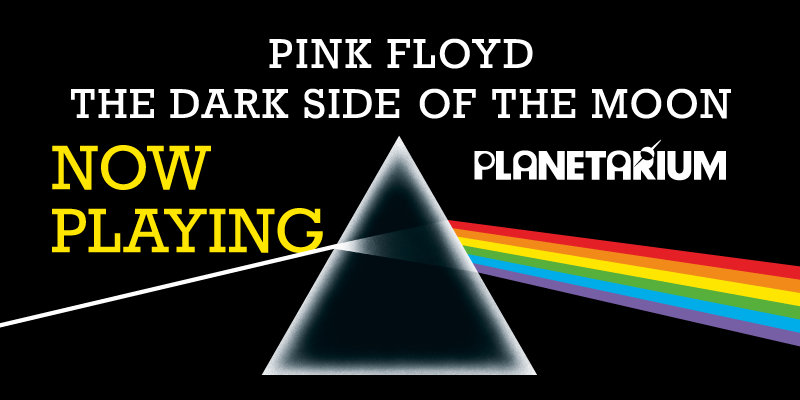
Pink Floyd’s iconic album The Dark Side Of The Moon, originally released in March 1973, turns 50, and what more fitting a place to celebrate it and experience it than in a Planetarium, through the music set to visuals. With the help of modern technology, the idea of a show combining breath-taking views of the solar system and beyond, played out to 42 minutes of The Dark Side Of The Moon in surround sound, has been embraced by the band. NSC Creative have led the visual production efforts, working closely with Pink Floyd’s long time creative collaborator Aubrey Powell from Hipgnosis.
Each song has a different theme; some futuristically looking forward and some a retro acknowledgment to Pink Floyd’s visual history, all relating to a time and space experience, embracing up to the minute technology that only a Planetarium can offer. A truly immersive and all-encompassing surround sound and visual treat that will transcend reality and take you way beyond the realms of 2D experience.
Food and drinks are not permitted within the Planetarium but will be made available for purchase prior to and following the performance
Friday and Saturday
-
6:00 pm
43 minutes, for all ages
LIVE SHOW
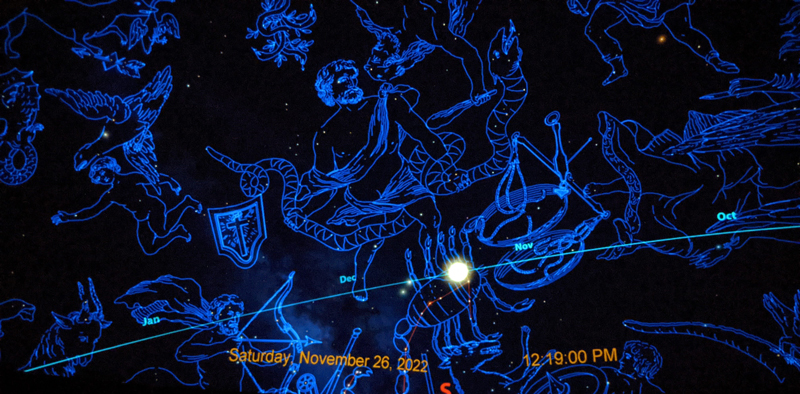
Our stellar Bluecoats are ready to take you on a unique space adventure. We can tour the night sky, update you on current space missions, and respond to your questions and requests. Want to see your favourite constellation? Tour the solar system? Fly right out of our galaxy? Let us know!
Monday to Friday
-
2:15pm (en français)
-
3:15pm
Saturday and Sunday
-
10:15am (en français)
-
11:15am
-
1:15pm
-
3:15pm
35 minutes, for all ages
EARTH, MOON & SUN
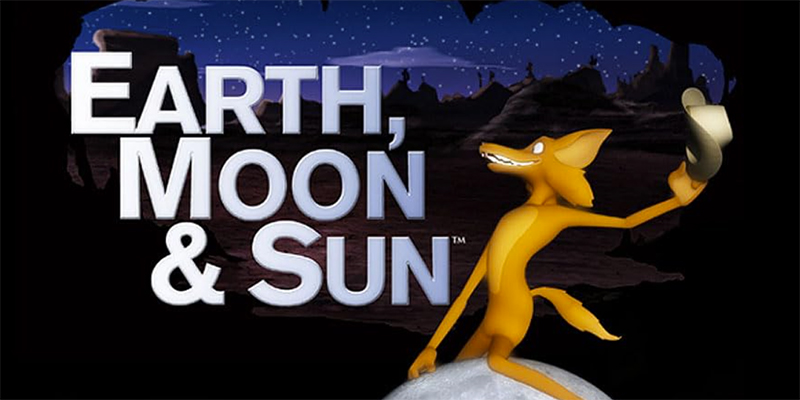
Join Coyote, an amusing character adapted from Native American oral traditions, as he explores the wonders of lunar phases, sunrises and sunsets, eclipses, space travel to our Moon and other relationships between the Earth, Moon and Sun. Native American stories are told throughout the show to help distinguish between myths and science.
Saturday and Sunday
-
2:15pm
26 minutes, for all ages
STAR PARTIES
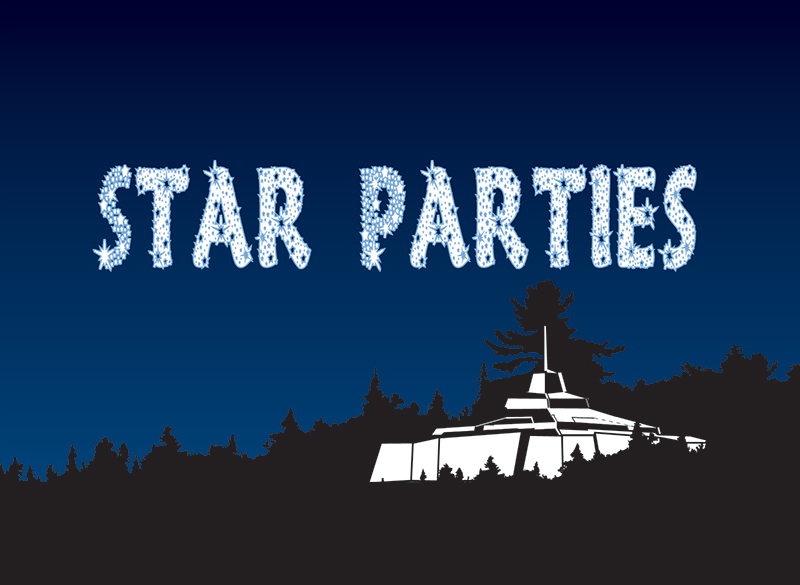
Join Science North Bluecoats for free Friday night Star Parties from May through August! Star Parties start one hour after sunset, run for 2 hours, and are located at the outdoor Pavilion beside the Patio at Science North! Sky map and orientation to the night sky provided, bring a chair and binoculars to find hidden gems. Sign-up onsite for viewing time with our telescope. For cool weather – dress warmly! For warm weather, expect mosquitoes!
Star Parties are weather permitting. To confirm, and please call the Star Party hotline at (705) 522-3701, ext. 243 after 5pm on Friday. Keep looking up!
SUDBURY SOLAR SYSTEM PATH
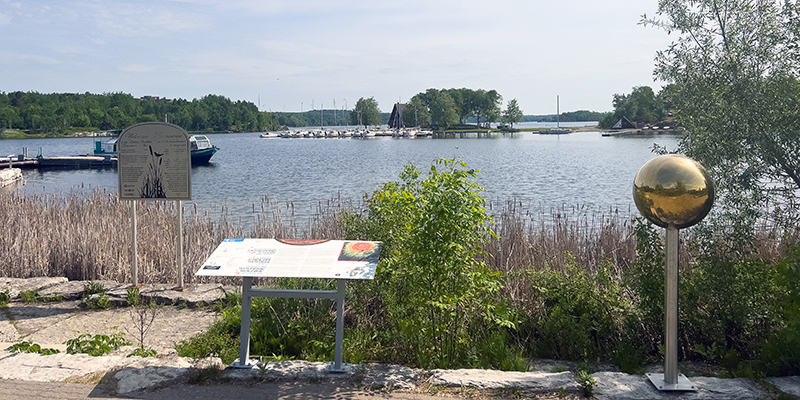
From here in N’swakamok (Sudbury), you can travel along the shore of Ramsey Lake and explore a scale model of our Solar System: the Sun and eight planets. Mercury, Venus, Mars, Jupiter and Saturn appear as bright “stars” in the sky. You can use binoculars or a telescope to see Uranus and Neptune.
The City of Greater Sudbury is on the traditional and ancestral land of the Atikameksheng Anishnawbek and Wahnapitae First Nations. The Anishinaabek refer to the Sun as Mishomis Giizis (Grandfather Sun). Mishomis Giizis provides us with guidance, direction, and the light and warmth that nurtures all our relations (plants, animals, rocks and planets).
For the Anishinaabek, life begins in Waabanong (the East), where the Sun rises, then moves along our life path to Ningawbewnong (the West), where it sets. The symbol of the Sun is also represented by the Ishkode (Sacred Fire) in Anishinaabek ceremonies.
- INDIGENOUS GUIDANCE
-
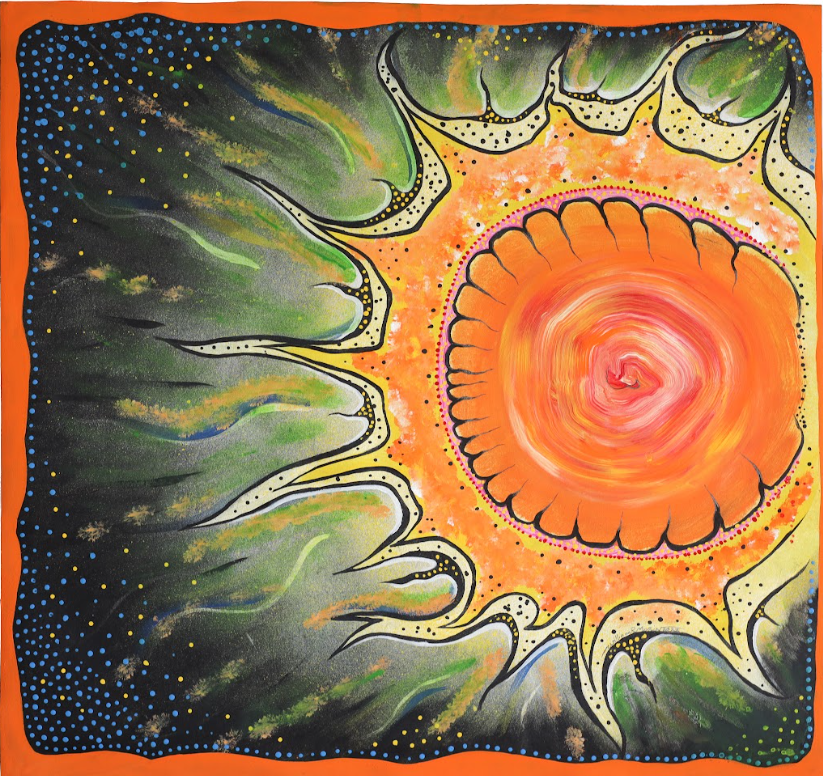 Science North is grateful to the Indigenous advisors who worked on the Solar System Path with us. An Anishinaabemwid (one who speaks Anishinaabemowin) from Adikamegshiing (Atikameksheng) Anishnawbek First Nation provided the Anishinaabemowin interpretation on the introductory sign. Dominic Beaudry, Member of the Science North Northeast Indigenous Advisory Committee and Anishinaabe educator from Sudbury and Manitoulin region provided guidance and the Anishinaabemowin planet names based on a discussion he had with his aunt, Kateri Beaudry, from Wikwemikong First Nation. Will Morin, a local Ojibwe educator, storyteller, and artist provided Indigenous knowledge and artwork.
Science North is grateful to the Indigenous advisors who worked on the Solar System Path with us. An Anishinaabemwid (one who speaks Anishinaabemowin) from Adikamegshiing (Atikameksheng) Anishnawbek First Nation provided the Anishinaabemowin interpretation on the introductory sign. Dominic Beaudry, Member of the Science North Northeast Indigenous Advisory Committee and Anishinaabe educator from Sudbury and Manitoulin region provided guidance and the Anishinaabemowin planet names based on a discussion he had with his aunt, Kateri Beaudry, from Wikwemikong First Nation. Will Morin, a local Ojibwe educator, storyteller, and artist provided Indigenous knowledge and artwork.Mishomis Giizis. Credit: Will Morin
- SUN
-
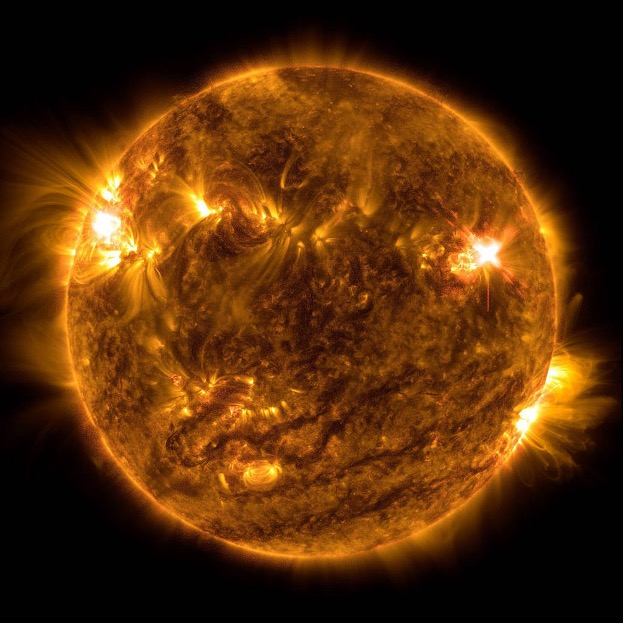
Ever wonder where the Sun gets its life-giving energy? The Sun’s gravity is so immense, that at its core atoms of hydrogen are squeezed together to form helium in a process called nuclear fusion. Every second, our Sun fuses 620 million tonnes of hydrogen, creating 616 million tonnes of helium. What happens to the other 4 million tons? That’s where the energy comes from! According to Einstein’s equation, E=mc², 4 million tonnes of matter become 4 hundred trillion trillion joules of energy.
The surface temperature of the Sun is 5505°C: too hot for matter to be a solid, liquid, or even a gas. It becomes a fourth state of matter called plasma. Instead of electrically neutral atoms, plasma is a soup of electrons and positive ions. It’s just too hot for atoms to hold onto electrons. It only gets hotter as you descend into the plasma: at the Sun’s core, it’s about 15 million°C.
The ions at the sun’s surface are so hot that some of them are constantly boiling off, creating a stream of particles called the solar wind, which passes through our solar system. The ions of the solar wind are a form of radiation. On Earth, we are protected from this radiation by our thick atmosphere and strong magnetic field, which funnels the solar wind to the poles – creating the northern (and southern) lights.
The Sun, imaged by the Solar Dynamics Observatory satellite. Credit: NASA/SDO
- MERCURY
-
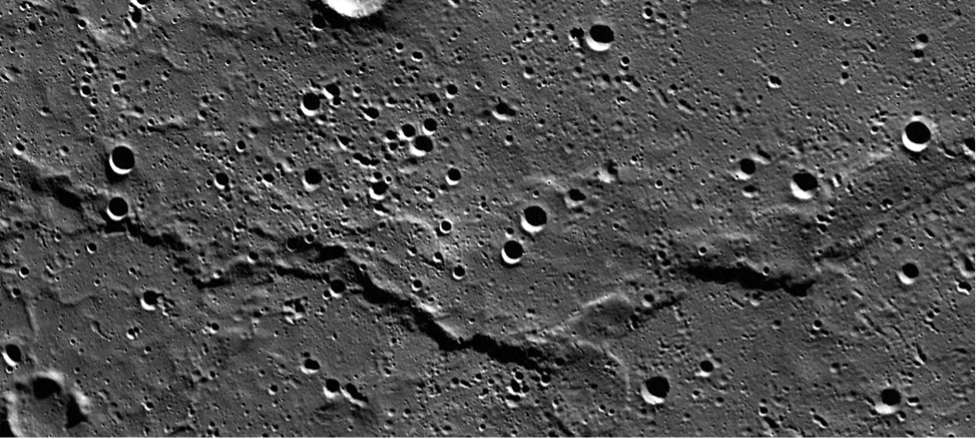 Mercury isn’t just the smallest planet: it’s also shrinking! Since its formation, scientists estimate Mercury has shrunk ~7 km. That has left the planet with a series of wrinkles and cracks in its crust, called ‘lobate scarps’ and ‘wrinkle ridges’. Unlike Earth, Mercury has no tectonic plates, so these ridges help shape the landscape that is otherwise uniformly covered with impact craters.
Mercury isn’t just the smallest planet: it’s also shrinking! Since its formation, scientists estimate Mercury has shrunk ~7 km. That has left the planet with a series of wrinkles and cracks in its crust, called ‘lobate scarps’ and ‘wrinkle ridges’. Unlike Earth, Mercury has no tectonic plates, so these ridges help shape the landscape that is otherwise uniformly covered with impact craters.Mercury’s surface gravity is 38% of what we have on earth — so a 100 lb. human would weigh only 38 lbs. on Mercury. That’s not much, but it’s more than expected for this tiny world because Mercury is very heavy for its size compared to other planets, so it has higher gravity too. Scientists believe this is because Mercury has a large iron core — like Earth’s, but proportionally larger. As with Earth, this iron core helps form Mercury's magnetic field.
Mercury has no moons or rings, but it may potentially have ice. Just like on the Earth’s moon, there are craters at the poles of Mercury that are in permanent shadow: sunlight never touches their bottoms. That would create a permanently cold area that could potentially trap ice from comets. Though such ice deposits have been detected on the Moon, no such discovery has yet been made on Mercury.
Mercury rotates around its axis about once every 58 days, but it takes 176 days from one sunrise to the next. That’s because Mercury is moving around the Sun so fast (once every 88 days) that the movement of the planet around the Sun is equally important to day length, stretching out the planet’s days.
Wrinkles on Mercury. Credit: NASA/Johns Hopkins University Applied Physics Laboratory/Carnegie Institution of Washington
- VENUS
-
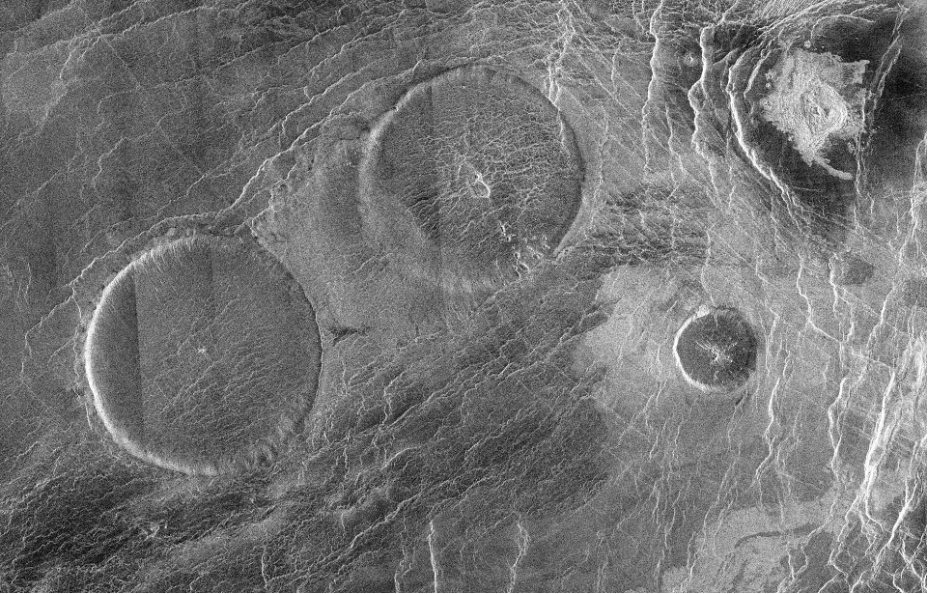
Venus spins backwards compared to the other planets: on Venus, the sun would rise in the West and set in the East. It has the slowest known spin: once on its axis every 243 days. That’s only a bit longer than Venus’s year, which is 225 days. Like on Mercury, the slow rotation and fast year combine to create a different day-night cycle. On Venus, it is 117 Earth-days between sunrise and sunset.
Venus is nearly the same size as Earth and has a similar structure in many ways: an iron core, a rocky mantle, and a rock crust. On the other hand, Venus has no magnetic field. It also has no tectonic plates, the large rafts of rock that allow Earth’s continents to slide about and make mountains and earthquakes, and most volcanoes.
Despite that, the surface of Venus is dominated by volcanoes and lava planes. Unlike Mercury or the Moon, which are “all craters, all the time,” most of the impact craters on Venus have been erased by volcanic activity. Volcanoes are the dominant surface feature. These volcanoes are mostly dome-shaped, like the shield volcanoes in Hawaii. Radar mapping of the surface has revealed thousands of them.
Venus’s surface needed to be mapped using radar because of the unending cloud-cover. Before the 1950s some people hoped that the clouds were water, and that Venus had rainforests, but no. It was definitively proven that the clouds are sulfuric acid, and that the surface is much, much hotter than any rainforest: 464°C on average. At least it is a dry heat: water is only present in barely detectable trace amounts in the Venusian atmosphere, ~20 parts-per-million. That means for every million molecules in Venus’ atmosphere, only 20 are H²O.
Volcanic domes on Venus. Credit: NASA/Jet Propulsion Laboratory
- EARTH AND MOON
-
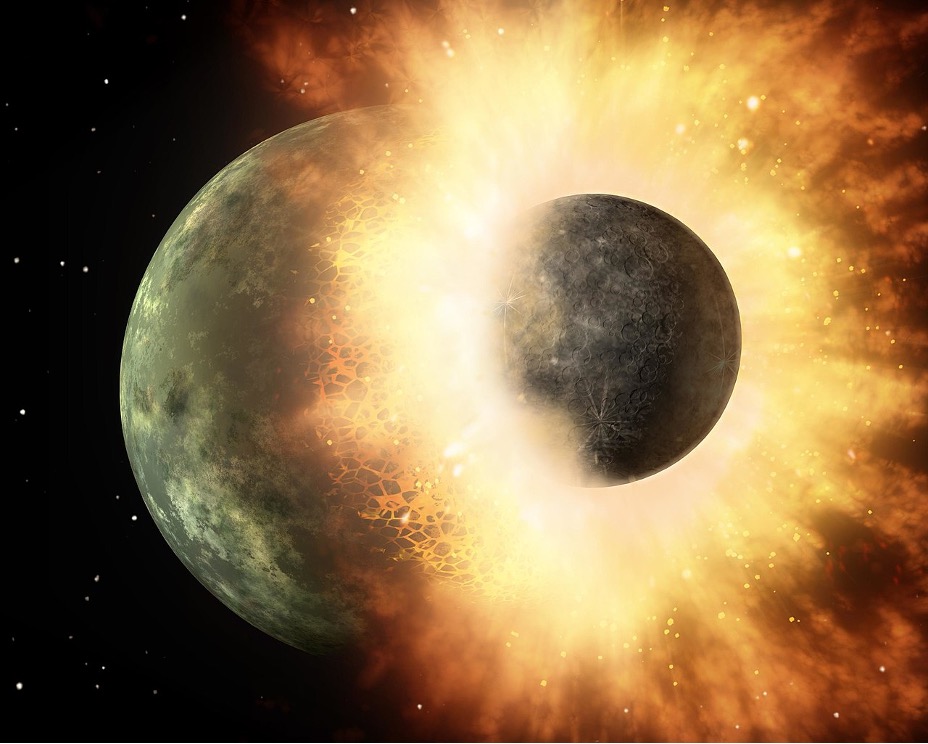 The Earth is the only terrestrial (that is, rocky) planet with a large moon. Mercury doesn’t have a moon. Venus doesn’t have a moon. Mars’ moons are tiny. Why is Earth special? The current theory is that, once upon a time, some 4.5 billion years ago, the Earth was struck by a Mars-sized planetoid scientists have called Theia. In Greek Mythology, Theia was the mother of the moon goddess Selene. The Moon formed in the aftermath, from chunks knocked from the Earth and what was left of Theia. Some versions of the theory suggest that before the moon reformed, the Earth briefly had a ring of lava.
The Earth is the only terrestrial (that is, rocky) planet with a large moon. Mercury doesn’t have a moon. Venus doesn’t have a moon. Mars’ moons are tiny. Why is Earth special? The current theory is that, once upon a time, some 4.5 billion years ago, the Earth was struck by a Mars-sized planetoid scientists have called Theia. In Greek Mythology, Theia was the mother of the moon goddess Selene. The Moon formed in the aftermath, from chunks knocked from the Earth and what was left of Theia. Some versions of the theory suggest that before the moon reformed, the Earth briefly had a ring of lava.If the theory is true, we can also thank Theia for our seasons. The Earth’s rotation is tilted relative to the plane of the solar system, and that creates the seasons as we go around the Sun. There’s not really any reason for a planet to have formed that way. The easy explanation is that something gave the Earth a nudge. That something might have been Theia.
We may owe even more than that to this mysterious planetoid: the Earth has a rather large iron core, we think, compared to its size. The extra iron contributes to our planet’s strong magnetic field — a magnetic field which helps preserve our atmosphere and our bodies from cosmic radiation and the solar wind. If that’s the case, life on Earth might owe its existence to this ancient collision.
The Moon is receding from the Earth at a rate of 3.8 cm per year. Eventually, in millions of years, scientists believe it will stop receding and come back towards us like a gravity-driven yo-yo.
Collision of Theia with Earth (artist’s depiction). Credit: NASA/JPL-Caltech
- MARS
-
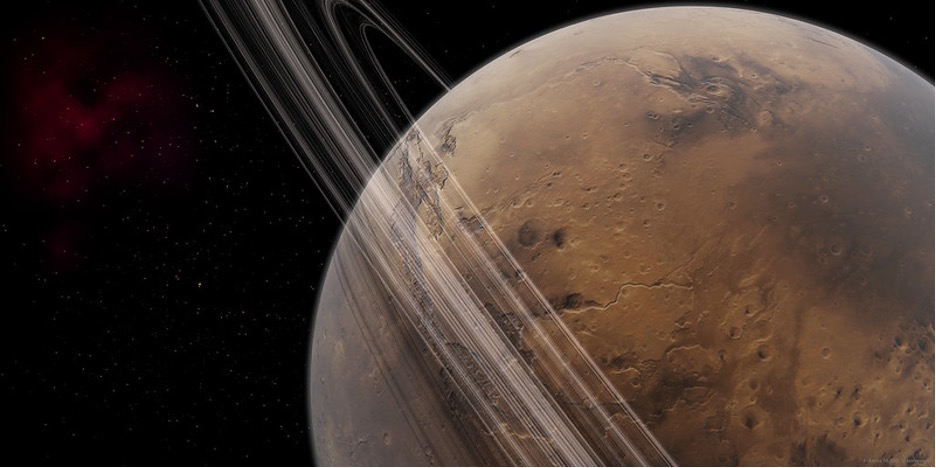 Mars has two tiny moons, Phobos and Deimos (named after the war god Ares’ twin sons with Aphrodite), thought to be captured asteroids. In mythology Phobos and Deimos were not true gods, but spirits, and that fits these itty-bitty moons to a T. Phobos is 22 km across; Deimos is only 12 km. At this scale, they would be smaller than your white blood cells (but bigger than red ones).
Mars has two tiny moons, Phobos and Deimos (named after the war god Ares’ twin sons with Aphrodite), thought to be captured asteroids. In mythology Phobos and Deimos were not true gods, but spirits, and that fits these itty-bitty moons to a T. Phobos is 22 km across; Deimos is only 12 km. At this scale, they would be smaller than your white blood cells (but bigger than red ones).Unlike Earth’s moon, which is slowly creeping away from Earth, Phobos is equally slowly descending towards the surface of Mars, at a rate of about 2 cm per year. In 30 to 50 million years, it will be close enough to be torn apart by Mars’ gravity. Some scientists predict this will result in Mars getting rings of its own — like Saturn, but in miniature. Others think it will just crash, but that’s no fun. We like to imagine the pretty rings Mars might someday have.
Mars is the most-visited planet, with a whopping 38 probes that have been launched at the red planet. Most failed in the attempt: in case you have not heard, rocket science isn’t easy. Many of those missions are trying to learn about the Martian past. Once upon a time, evidence suggests, Mars had water, and quite a lot of it. Perhaps seas, maybe even oceans. Now there are only small deposits of ice and a few super-salty aquifers underground. What happened to the environment on the Red Planet? Was life able to evolve when Mars was more hospitable, and was it somehow able to survive? These are some of the questions driving our exploration of Mars.
The Demise of Phobos (artist‘s depiction). Credit: Kevin Gill
- JUPITER
-
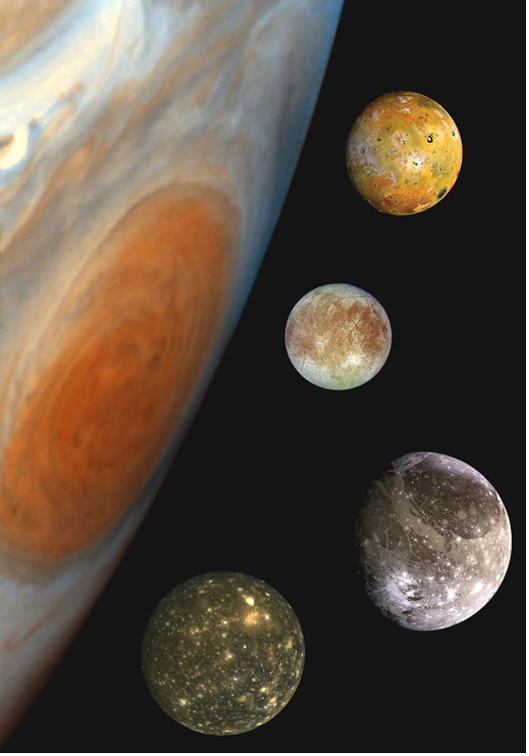
After Mars, Jupiter is the second-most visited planet in the 21st century — both because it is interesting, but also because it makes for an extremely useful pit stop. Jupiter is extremely massive (2.5x heavier than all the other planets combined) and that mass gives it a lot of gravity. A whole lot. Space probes can use that gravity as a slingshot to propel them to other destinations in the solar system—so while Jupiter has had nine robotic visitors, only two probes have stopped to orbit the giant planet: Galileo, in the 1990s, and the Juno space probe. Juno arrived at Jupiter in 2016 and is active to this day.
Though they are too small and dim to show up in a backyard telescope, Jupiter has a system of rings. They were only discovered in the 1970s by the Voyager 2 space probe. The rings are made of dust thrown up by meteorite impacts on the innermost of Jupiter’s 92 known moons.
Jupiter has four moons large enough to be visible through binoculars. They are Io, Europa, Ganymede and Callisto and are called the “Galilean Moons” after the person who discovered them. Ganymede is bigger than Mercury and would almost certainly be considered a planet if it orbited the Sun instead of Jupiter. Europa is slightly smaller than Earth’s Moon and is a candidate for life in our solar system because beneath its icy crust it has an ocean of liquid water.
Jupiter and the four Galilean moons (to scale, positions are illustrative). From top to bottom: Io, Europa, Ganymede, Callisto. Credit: NASA/JPL/DLR
- SATURN
-
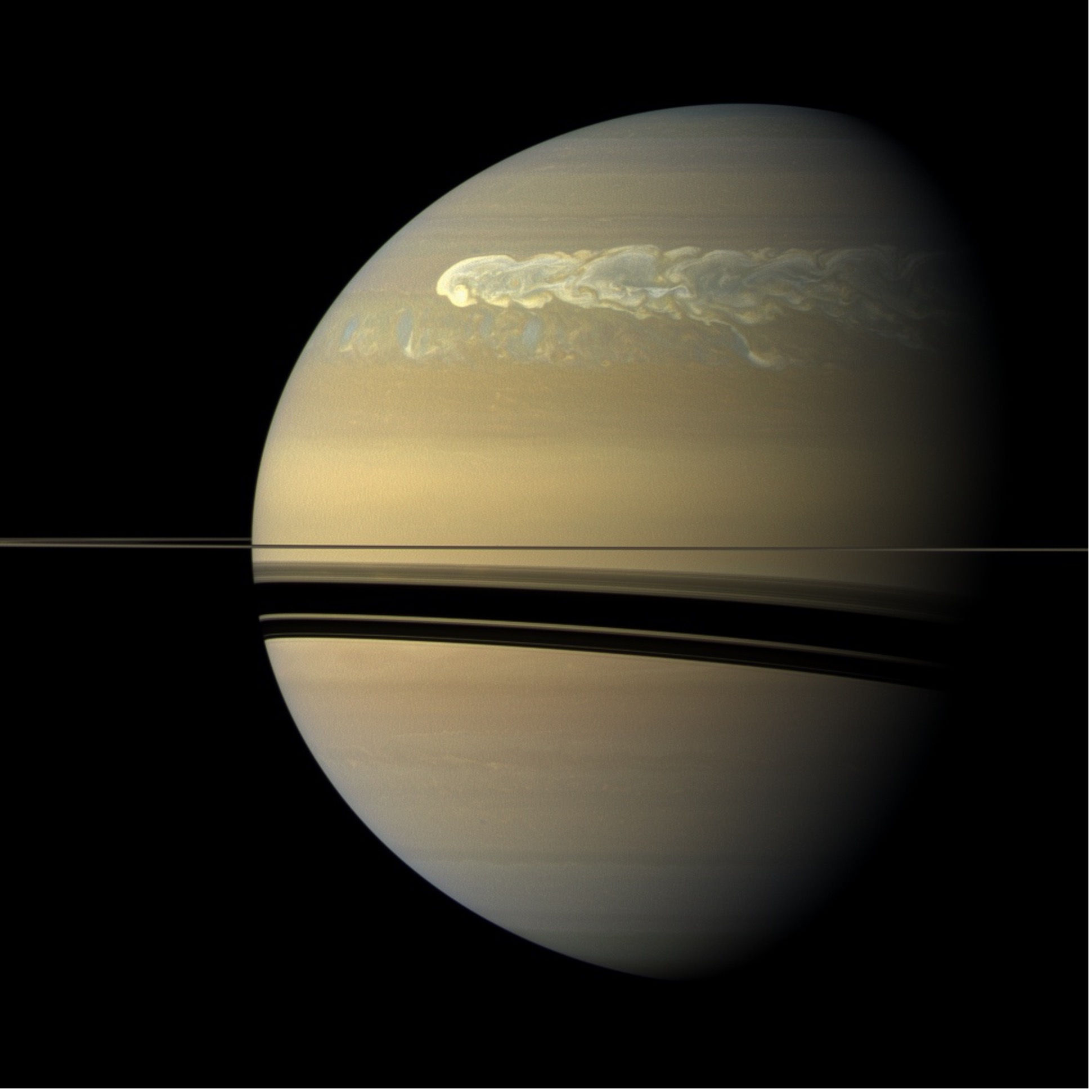 Saturn is the least round of the planets. No planet is a perfect sphere: because they spin, they bulge outwards at the middle and flatten slightly at the poles. Saturn is the least-dense planet, so its gravity has a harder time holding it into a spherical shape. It’s a whole 10% wider at the equator than from pole to pole: 120,536 km versus 108,728 km. That even affects the gravity — if you were riding on a blimp in Saturn’s clouds, you’d weigh 74% less at the equator than at the poles.
Saturn is the least round of the planets. No planet is a perfect sphere: because they spin, they bulge outwards at the middle and flatten slightly at the poles. Saturn is the least-dense planet, so its gravity has a harder time holding it into a spherical shape. It’s a whole 10% wider at the equator than from pole to pole: 120,536 km versus 108,728 km. That even affects the gravity — if you were riding on a blimp in Saturn’s clouds, you’d weigh 74% less at the equator than at the poles.If you were in a blimp exploring the clouds of Saturn, you’d need to keep the windows shut tight: there’s no oxygen for you to breathe. In fact, the atmosphere is 96% hydrogen. Hydrogen is a colourless gas; Saturn is yellow because of trace amounts of ammonia in the high atmosphere.
Once per Saturnian year — that is, every 30 Earth-years — there seems to be a giant storm, roughly equivalent to Jupiter’s Great Red Spot, that forms in Saturn’s northern hemisphere around the time of the summer solstice. Unlike Jupiter’s more famous (and larger) storm, Saturn’s tempests are white, more diffuse, and only last about one Earth year. Even if they aren’t as impressive as the Great Red Spot on Jupiter, scientists call them Great White Spots anyway.
A global storm in 2011. The storm passes around the planet so the storm’s head (bright area) passes its tail. Credit: NASA/JPL-Caltech/SSI
- URANUS
-
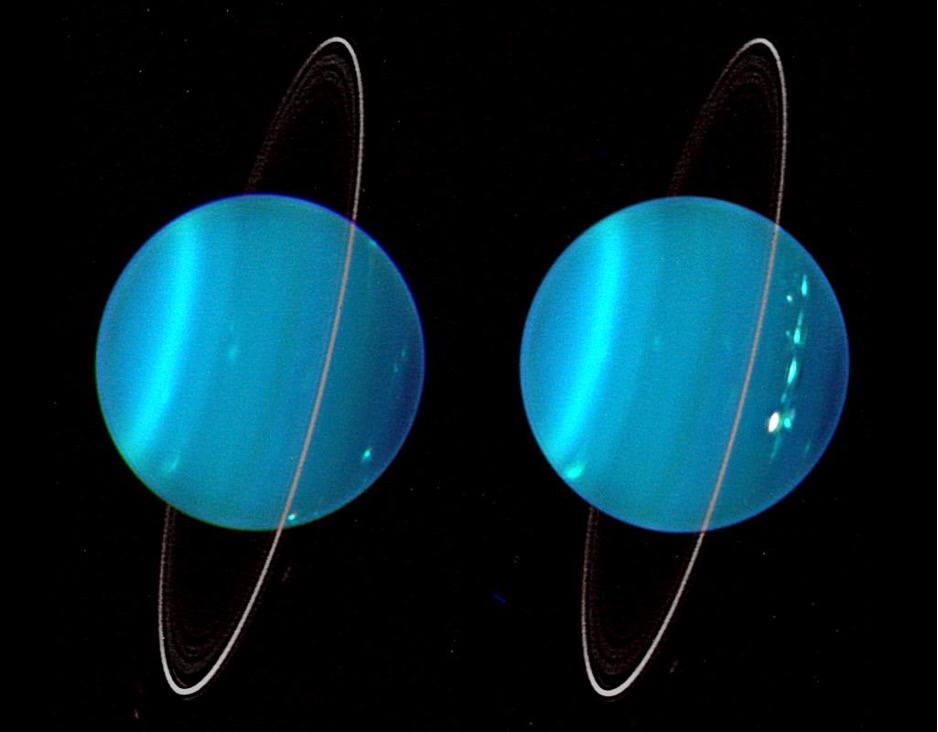 Uranus’ extreme axial tilt (97.77 degrees) gives it seasons unlike any other planet. Through the 42-year winter, almost half the planet is fully dark, the other half fully sunlit. Only for a brief period, around the spring and fall equinoxes, does the planet’s rotation have much to do with night and day. Since we have not had telescopes able to study the weather on Uranus for a full year (88 Earth years), scientists are still learning just how strange it is.
Uranus’ extreme axial tilt (97.77 degrees) gives it seasons unlike any other planet. Through the 42-year winter, almost half the planet is fully dark, the other half fully sunlit. Only for a brief period, around the spring and fall equinoxes, does the planet’s rotation have much to do with night and day. Since we have not had telescopes able to study the weather on Uranus for a full year (88 Earth years), scientists are still learning just how strange it is.Uranus’ 27 known moons orbit in-line with the planet’s rotation, rather than the plane of the solar system. That is normal for moons, but because the planet is tilted sideways, the sideways tilt of the moons’ orbits is also unique. The Uranian moons are named after characters from the works of William Shakespeare and Alexander Pope. The five largest are Titania, Miranda, Ariel, Umbriel, and Oberon.
Four billion years ago, Uranus may have been the furthest planet from the sun. There is a computer model — called the Nice model because it was developed in Nice, France — that was designed to explain the formation of the solar system. In that model, Uranus and Neptune both start much closer to the Sun than they are now — and switch places as they migrate outwards. Some versions of the model even include an extra ice-giant that gets ejected from the solar system entirely. Pretty Nice, eh?
Infrared composite image of the two hemispheres of Uranus. The North pole is at 4 o’clock. Credit: Lawrence Sromovsky, University of Wisconsin-Madison/W.W. Keck Observatory
- NEPTUNE
-
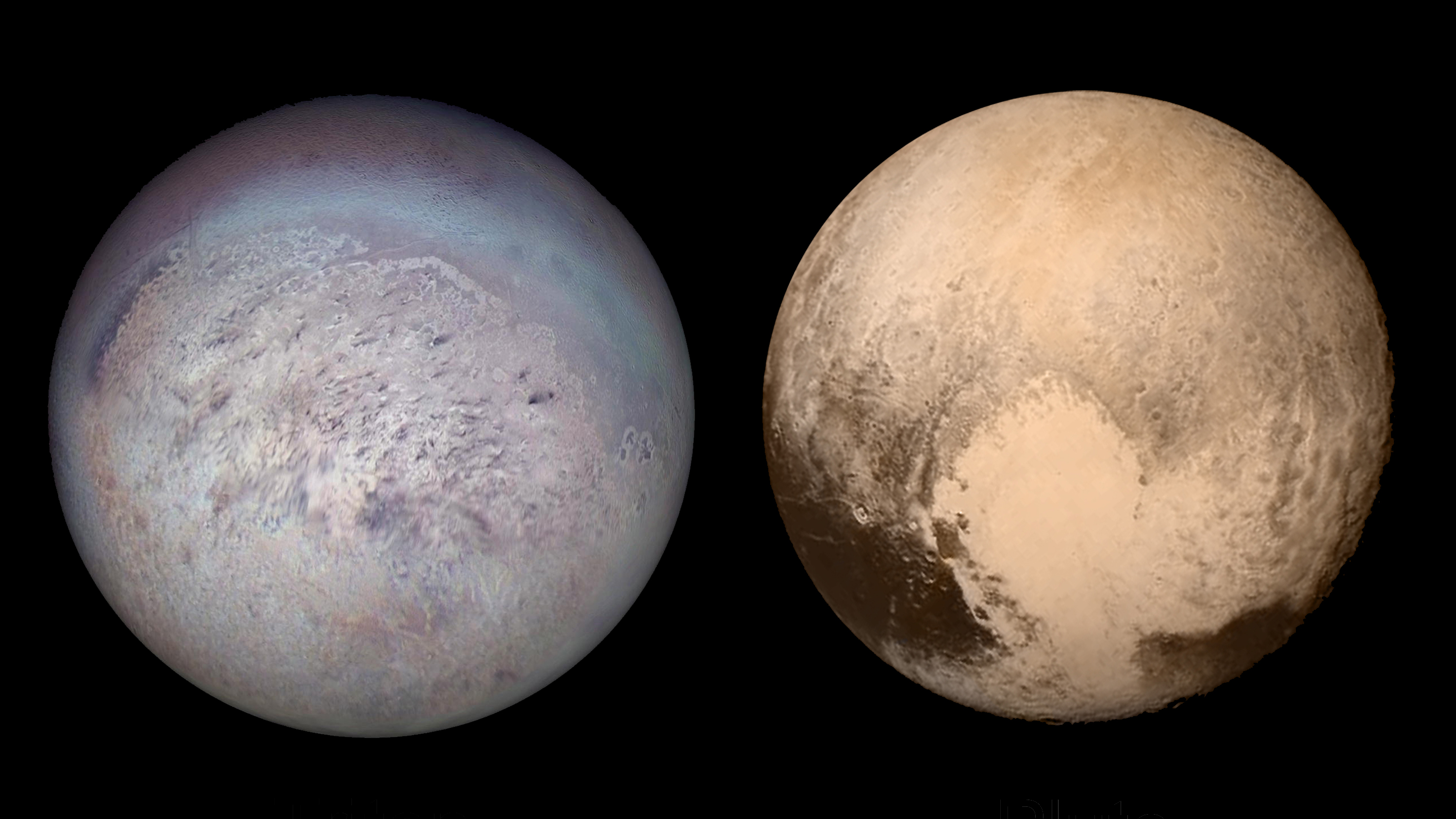 Neptune’s largest moon, Triton, is often considered Pluto’s ‘twin’ (though Triton is slightly bigger than Pluto) because the two are of very similar size and composition. They are mostly ices of different compounds that would be liquid on Earth, like water and ammonia. Triton orbits Neptune ‘retrograde’ — which is to say backwards compared to how the planet rotates. Scientists think Triton formed as a dwarf planet in orbit around the Sun, but that it came too close to Neptune and was captured by the planet’s gravity to become a moon.
Neptune’s largest moon, Triton, is often considered Pluto’s ‘twin’ (though Triton is slightly bigger than Pluto) because the two are of very similar size and composition. They are mostly ices of different compounds that would be liquid on Earth, like water and ammonia. Triton orbits Neptune ‘retrograde’ — which is to say backwards compared to how the planet rotates. Scientists think Triton formed as a dwarf planet in orbit around the Sun, but that it came too close to Neptune and was captured by the planet’s gravity to become a moon.The same thing could have happened to Pluto, but instead Pluto has fallen into what we call an ‘orbital resonance’ with Neptune: it orbits the Sun twice for every three times Neptune does. This resonance can stay stable over billions of years, so even though Pluto’s highly elliptical orbit crosses that of Neptune, the two are never expected to meet.
Neptune’s gravity has sorted out all the objects in the outermost solar system, a region of debris we call the Kuiper Belt: from ‘plutinos’ with a 2:3 orbital resonance to ‘twotinos’ with a 1:2 orbital resonance, and other ratios in between that don’t have cool names. That’s why Neptune gets to be a planet and Pluto doesn’t: because its gravitational pull was able to create these resonances, it has “cleared its orbit,” which is one of the three conditions for planet-hood, along with orbiting the Sun and being round.
We will end the walk here anyway: Pluto would be another 2 km away at its average distance from the Sun, and we seem to have run out of path.
Triton (left) as seen from Voyager 2 and Pluto (right) as seen from New Horizons. Credit: A. Tayfun Oner (Triton) / NASA/JHUAPL/SWRI (Pluto)
CONTACT:
Olathe MacIntyre
Staff Scientist, Space Place and Planetarium
(705) 522-3701 ext. 341
planetarium [at] sciencenorth.ca (planetarium[at]sciencenorth[dot]ca)
Star Parties are generously supported by






